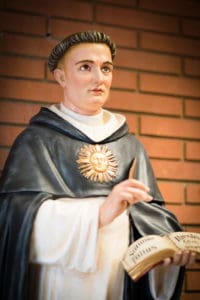St. Thomas Aquinas
St. Thomas Aquinas (1225–1274)
 St. Thomas, the offspring of Italian nobility, was born in the family castle of Rocca Secca north of Naples in about 1225. While a student at the University of Naples, Thomas met the Dominican friars and received the habit. Thomas’ family, preferring for him the powerful position of abbot of the Benedictine Abbey Monte Cassino, rather than life as a begging friar in a humble new order, had him kidnapped and imprisoned, in the hope that this would change his mind. Thomas’ brothers even sought to destroy his vocation by sending an evil woman to seduce him, but the young Thomas drove her from his cell with a flaming torch, then knelt and prayed for deliverance from all temptations against chastity. God sent angels to minister to Thomas and to gird him with a cincture of perpetual chastity.
St. Thomas, the offspring of Italian nobility, was born in the family castle of Rocca Secca north of Naples in about 1225. While a student at the University of Naples, Thomas met the Dominican friars and received the habit. Thomas’ family, preferring for him the powerful position of abbot of the Benedictine Abbey Monte Cassino, rather than life as a begging friar in a humble new order, had him kidnapped and imprisoned, in the hope that this would change his mind. Thomas’ brothers even sought to destroy his vocation by sending an evil woman to seduce him, but the young Thomas drove her from his cell with a flaming torch, then knelt and prayed for deliverance from all temptations against chastity. God sent angels to minister to Thomas and to gird him with a cincture of perpetual chastity.
After a year of imprisonment, Thomas escaped with the help of his sisters and returned to the Dominicans. Following a period of formation and study at Cologne and Paris under the tutelage of St. Albert the Great, Thomas began his life’s work of teaching and writing. He taught at universities and Dominican houses in Paris, Rome and Naples. His written works include commentaries on the Sacred Scriptures and on the works of the philosopher Aristotle, and his best known work, the Summa Theologiae (a work giving the theological foundation of the truths of the Catholic faith).
A gentle, humble man, St. Thomas had a deep devotion to the cross of Christ. He said that he had learned more from the crucifix than from any book. He began all his works in prayer at the foot of the cross. His love for Christ in the Eucharist is apparent in the hymns and prayers he composed for the liturgy for the Feast of Corpus Christi. The best known of these hymns are O Salutaris Hostia, Tantum Ergo Sacramentum, and Panis Angelicus.
In his brief life — he was only about fifty when he died — he left a treasury of wisdom and learning for the Church which has honored him with the “Angelic Doctor.” Both the Council of Trent and the Second Vatican Council relied on and explicitly mentioned his works, especially the Summa Theologiae.
Before his death St. Thomas had a vision or “mystical experience” which caused him to cease writing, saying that everything he had written seemed as straw compared to what he had seen. In 1274, while traveling from Naples to attend the Council of Lyons at the request of the pope, Thomas struck his head on a low-hanging tree branch. His companions took him to the nearby home of his sister. When Thomas realized he would not recover, he asked his brothers to take him to the Cistercian monastery at Fossanova. He died there on March 7 and was buried in a chapel in the monastery. His remains have since been returned to the Dominican Order and lie in Toulouse, France. St. Thomas was one of the greatest and most influential theologians of all time. He was canonized in 1323 and declared Doctor of the Church by Pope Pius V.

